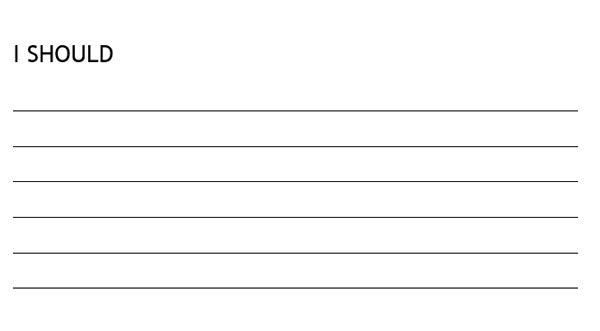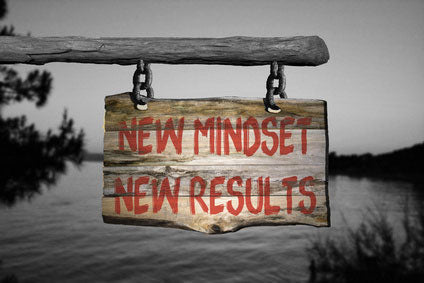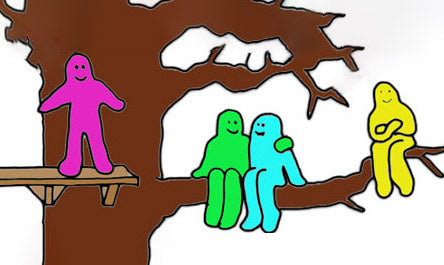Purpose
This exercise is designed to make the coachee think about potential liming views and beliefs. Through a systematic step by step process, you first help the coachee see what these beliefs are and then gradually lead them to see how they can be limiting. Often, such limiting beliefs are the root cause of many unwanted behaviours. They manifest themselves in thoughts and in actions. This exercise helps to go back to the root cause of issues and aim to address them.
It is best to run this exercise on an individual basis such as in a coaching or mentoring session. Before embarking on this exercise, create a safe and trusting environment where the coachee feels comfortable sharing their weaknesses with you.
Objective
Identify a set of believe statements starting with “I should” and use this as the basis for discovering wrong beliefs which can then be addressed.
What You Need
- Papers
Setup
- Make the coachee feel comfortable. Perhaps start with a conversation where they can talk about themselves. Ask them to tell you about their childhood.
- Provide papers and a pen.
- Ask the coachee to write “I should” at the top of the page. The coachee should then complete the sentence in five to ten different ways.
- Examples:
- “I should be strong.”
- “I should be at my best.”
- “I should remain quiet over dinner.”
- “I should get a post graduate degree.”
- Beware that some people may struggle to start so give them plenty of time.
- Once finished, ask the coachee to read the list to you one at a time.
- As you hear each statement, ask “Why?”
- The answers are often revealing and quite interesting. They can lead both of you to a conversation. Don’t interrupt the coachee at this point though. Listen to answers and take notes.
- Here are examples of answers for statements listed above:
- “Because my dad wanted me to be strong.”
- “Because I have to be perfect.”
- “Because my mum told me so.”
- “Because my brother and sister have a PhD and my family wants me to follow suit.”
- As you remain quiet, the coachee will feel the silence and may give you more clues. Listen carefully and take notes:
- …Because I am too slow, too tall, too short, too ugly, too fat, too thin, unprivileged, etc…
- These answers help you see where they are stuck in their belief system.
- Now, explain that the word “should” is a particularly damaging word and needs to be avoided. Every time you say “should” you mean that you are or were wrong; that you are not good enough and you are not doing or being something that you should be.
- Explain that instead of “should”, the coachee must use “could”.
- Ask the coachee to read through the list again and this time convert the “should” in each statement to “could”:
- “If I really wanted to, I could…”
- Ask the coachee to see if anything can be dropped from the “should” list that would lead to a sense of relief? Why keep it there then?
- Summarise what you have covered in this exercise:
- That some limiting beliefs are there because the coachee wants to please others.
- That these limiting believes can be eliminated once the coachee knows they are not needed.
- That the coachee must aim to avoid “should” and replace it with “could”.
- That the coachee doesn’t have to live according to someone else’s standard. People always have a choice.
- That the point of power is in the present moment. The coachee can change right now, this very moment, if there is a will.
Timing
Explaining the Exercise: 5 minutes
Activity: 20 minutes
Group Feedback: N/A
Discussion
N/A
Soft Skills Training Materials
Get downloadable training materials
Online Train the Trainer Course:
Core Skills
Learn How to Become the Best Trainer in Your Field
All Tags
Training Resources for You

Course Design Strategy
Available as paperback and ebook

Free Training Resources
Download a free comprehensive training package including training guidelines, soft skills training activities, assessment forms and useful training resources that you can use to enhance your courses.

Our Comprehensive Guide to Body Language

Train the Trainer Resources
Get Insights - Read Guides and Books - Attend Courses
Training Materials
Get downloadable training materials on: Management Training, Personal Development, Interpersonal Development, Human Resources, and Sales & Marketing














Leave a comment
All comments are moderated before being published.
This site is protected by hCaptcha and the hCaptcha Privacy Policy and Terms of Service apply.